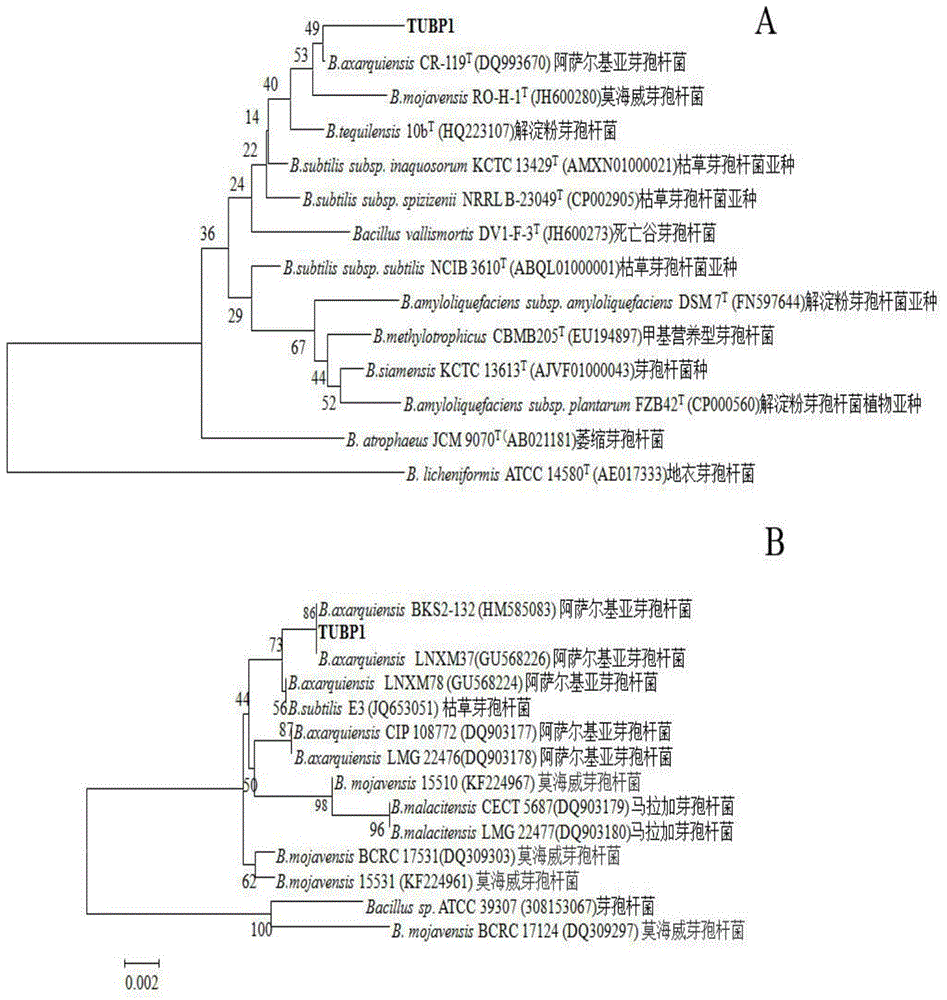Application of bacillus axarquiensis to prevention and treatment of verticillium dahliae
A technology of Bacillus asalki and cotton verticillium wilt, which is applied in the agricultural field, can solve the problems of no related reports on the disease prevention effect of cotton verticillium wilt, no related research on biological activity and the like.
- Summary
- Abstract
- Description
- Claims
- Application Information
AI Technical Summary
Problems solved by technology
Method used
Image
Examples
Embodiment 1
[0013] Example 1: Antagonist primary screening and secondary screening
[0014] Cotton Verticillium dahliae bacterial liquid preparation: inoculate Verticillium dahliae V.dahliae ATCC36211 on a plate containing PDA medium, culture at 25°C for 15 days, add sterile water to the plate, scrape the spores, count them with a hemocytometer, and adjust the concentration of the bacterial liquid 6×10 6 Spore mL -1 ,spare.
[0015] Isolation and screening of antagonistic bacteria: according to the routine method of isolating soil bacteria. The isolated and purified single colonies were inoculated on NA medium, cultured at 37°C for 48 hours at 180 rpm, and made into fungus cakes with a 6mm hole punch. Spread 200 μL 6×10 on PDA medium 6 mL -1 Cotton Verticillium dahliae spore suspension, and then the bacteria cake of the isolated and purified strain was reversely connected to the plate. Incubate at 25°C for 4 days, and screen for antagonistic bacteria that produce inhibition zones. ...
Embodiment 2
[0022] Example 2: Morphological and physiological and biochemical identification of antagonistic bacteria TUBP1. The activated antagonistic bacteria TUBP1 strain was inoculated on NA plates and cultured at 37°C for 48 hours, and Gram staining was performed to observe the colony morphology, bacteria and spores, and physiological and biochemical identification (methyl red test, starch hydrolysis test, sugar alcohol fermentation test, fluorochrome test, etc.).
[0023] The colony and morphological characteristics of Verticillium dahliae antagonistic strain TUBP1, TUBP1 grows on NA medium, the single colony of TUBP1 is round, the surface is shrunken, dry, dull, opaque, the edge is not smooth, milky white ( figure 1 A), Gram staining is positive (G+), and it has spores, motility, and metachromosomal tests are positive. Observed under a scanning microscope, the bacteria were rod-shaped ( figure 1 B)
[0024] Physiological and biochemical assay results of Verticillium dahliae anta...
Embodiment 3
[0029] Example 3: Phylogenetic analysis of Verticillium dahliae antagonistic bacteria TUBP1 based on BLAST results of 16S rDNA and gyrB gene sequences
[0030] Antagonistic bacterial TUBP1 gene sequence PCR amplification, 16S rDNA PCR amplification, antagonistic bacterial TUBP1 genomic DNA was extracted as a template, and universal primers were used for 16S rDNA sequence PCR amplification. The amplified product was cloned and sent to Shanghai Sangon Bioengineering Technology Service Co., Ltd. for sequencing. The result is shown in SEQ ID No1.
[0031] PCR amplification of gyrB gene sequence, extraction of antagonistic TUBP1 DNA, and degenerate primers UP-1S (5'GAA GTCATCATGACCGTTCTGCA3', SEQ ID No2) and UP-2Sr (5'AGCAGGGTAC GG ATGTGCG A GCC3', SEQ ID No3) Amplify the gyrB gene, reaction conditions: 95°C for 5min; 95°C for 30s, 58°C for 45s, 72°C for 2min, 30 cycles; 72°C for 10min. The amplified product was cloned and sent to Shanghai Sangon Bioengineering Technology Service ...
PUM
 Login to View More
Login to View More Abstract
Description
Claims
Application Information
 Login to View More
Login to View More - R&D Engineer
- R&D Manager
- IP Professional
- Industry Leading Data Capabilities
- Powerful AI technology
- Patent DNA Extraction
Browse by: Latest US Patents, China's latest patents, Technical Efficacy Thesaurus, Application Domain, Technology Topic, Popular Technical Reports.
© 2024 PatSnap. All rights reserved.Legal|Privacy policy|Modern Slavery Act Transparency Statement|Sitemap|About US| Contact US: help@patsnap.com










